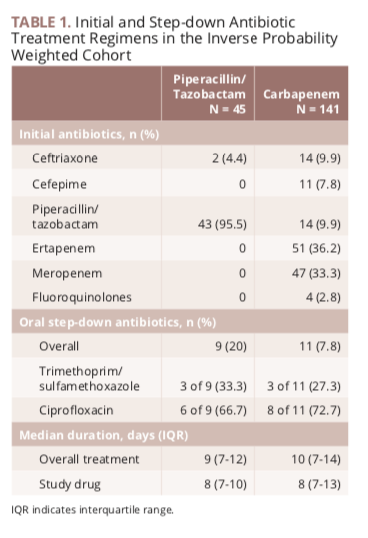Piperacillin/Tazobactam for the Treatment of ESBL Pyelonephritis: A Redemption Arc
Interests have recently skewed toward the use of carbapenem-sparing regimens in light of growing selection for carbapenem-resistant organisms.
Featured Study:
Is piperacillin-tazobactam effective for the treatment of pyelonephritis caused by ESBL-producing organisms?
Sharara SL, Amoah J, Pana ZD, et al. Clin Infect Dis. doi: 10.1093/cid/ciz1205.
Gram-negative bacteria that produce extended-spectrum β-lactamase (ESBL) enzymes are a prevalent global threat because of their efficiency in hydrolyzing and rendering many β-lactam antibiotics ineffective. Carbapenems, over time, became the treatment of choice for ESBL infections. However, interests have recently skewed toward the use of carbapenem-sparing regimens in light of growing selection for carbapenem-resistant organisms.1
Piperacillin/tazobactam, a commonly used agent, retains a broad spectrum of activity against many gram-negative pathogens. Tazobactam, a β-lactamase inhibitor, restores in vitro activity to piperacillin particularly in the presence of ESBL genes.2 Prior clinical experience with using piperacillin/ tazobactam for invasive ESBL infections resulted in mixed conclusions until the MERINO trial (NCT02176122).3 In MERINO, piperacillin/ tazobactam failed to reach noninferiority in 30-day mortality rates compared with meropenem for the treatment of ESBL bacteremia.4
Despite these results, the utility of piperacillin/tazobactam for less complicated ESBL infections is still debated. Its use in urinary infections is particularly appealing, due to both the prevalence of infections and the concentration of drug. Piperacillin/tazobactam displays a high degree of renal drug excretion, theoretically providing a high enough concentration to overcome resistance mechanisms in the urine. In a retrospective study, Sharara and colleagues further explored this by comparing piperacillin/tazobactam and carbapenems for upper urinary tract infections.5
Patients were included following a diagnosis of pyelonephritis caused by a molecularly confirmed ESBL-producing Enterobacterales and receipt of either piperacillin/tazobactam or a carbapenem within 48 hours from initial urine culture. Medications had to be continued for at least 72 hours, unless transitioned to a fluoroquinolone or trimethoprim- sulfamethoxazole for the remainder of therapy. Relevant exclusion criteria included receipt of antibiotics not susceptible to the uropathogen or with suboptimal penetration into renal parenchyma, receipt of the alternative study drug following 72 hours of initial therapy, and presence of concomitant infections including bacteremia and renal abscess.
The primary outcome was the rate of 30-day recurrence of cystitis or pyelonephritis with the index organ. Secondary outcomes included rates of symptom resolution by day 7 of therapy, 30-day mortality, and identification of carbapenem-resistant organisms in the 60 days following the start of antibiotics.
Authors used inverse probability weighting to account for baseline population differences between the 2 treatment arms. In brief, multi- variate logistic regression is performed to iden- tify influential patient characteristics that may broadly affect receipt of 1 of the 2 treatment arms. Taking into consideration these factors, a separate population is created to balance the propensity for high-risk or tenuous patients to preferentially receive meropenem in light of an ESBL-producing pathogen and provide more weight to those receiving the “unexpected” drug.
Overall, 188 patients met inclusion, with 47 (25%) receiving piperacillin/tazobactam and 141 (75%) receiving a carbapenem. The process of inverse probability weighting included 45 (24%) patients receiving piperacillin/tazobactam and 141 (76%) receiving a carbapenem. Patients in both treatment arms had a median age of about 63 years, with a slight female predominance (~68%). Overall baseline demo- graphics were notable for fairly high rates of immunosuppression (48%), urologic abnormalities (45%), and intensive care unit admission (27%). The most common uropathogens were Escherichia coli (56%) and Klebsiella pneumo- niae (30%), with most harboring a CTX-M (87%) or SHV-type (24%) ESBL gene. Median minimum inhibitory concentrations were 2 mcg/ML (interquartile range [IQR]: 2-8) and 2 mcg/ML (IQR: 2-16) mcg/mL in the piperacillin/tazobactam and carbapenem groups, respectively. Details on the initial antibiotics used, including durations and rates of oral step-down, are listed in Table 1.
Results of the primary and secondary outcomes within the weighted cohort are summarized in Table 2 online. Ultimately, there were no differences seen between the arms across all outcomes. Notably, there was a higher numerical but not statistical rate of subsequent carbapenem-resistant isolates observed in the carbapenem arm compared with the piperacillin/tazobactam arm, particularly with non—lactose fermenting rods.
Many nuances and factors affect a clinician’s choice of antibiotics in the setting of an ESBL pathogen, including infection severity and site. This study suggests that for urinary ESBL infections, piperacillin/tazobactam may still be a treatment option. However, external validity and applicability rest on methods of ESBL identification (ie, genotypic vs phenotypic) and regional distributions of resistance genes, as well as institutional differences in dosing and administering antibiotics (ie, intermittent vs extended infusion). Another commonly used antibiotic, cefepime, although structurally stable against many β-lactamases, has similarly conflicting data in treating ESBL infections.6 As increased pressure for carbapenem-sparing regimens develops, future prospective studies investigating both piperacillin/tazobactam and cefepime are needed to define their place in therapy for ESBL infections.

Lee is an infectious diseases clinical pharmacy specialist at the Hospital of the University of Pennsylvania in Philadelphia, PA. Her practice areas include inpatient antimicrobial stewardship, as well as the transition & monitoring of patients receiving outpatient parenteral antimicrobial therapy. *She is an active member of the Society of Infectious Diseases Pharmacists.
References:
- Richter SE, Miller L, Needleman J, et al. Risk factors for development of carbapenem resistance among gram-negative rods. Open Forum Infect Dis. 2019;6(3):ofz027. doi: 10.1093/ofid/ofz027.
- Marchaim D, Sunkara B, Lephart PR, et al. Extended-spectrum β-lactamase producers reported as susceptible to piperacillin-tazobactam, cefepime, and cefuroxime in the era of lowered breakpoints and no confirmatory tests. Infect Control Hosp Epidemiol. 2012;33(8):853-855. doi: 10.1086/666632.
- Harris PNA, Tambyah PA, Lye DC, et al. Effect of piperacillin-tazobactam vs meropenem on 30-day mortality for patients with E coli or Klebsiella pneumoniae bloodstream infection and ceftriaxone resistance: a randomized clinical trial [published correction appears in JAMA. 2019;321(23):2370]. JAMA. 2018;320(10):984-994. doi: 10.1001/jama.2018.12163.
- Sharara SL, Amoah J, Pana ZD, Simner PJ, Cosgrove SE, Tamma PD. Is piperacillin-tazobactam effective for the treatment of pyelonephritis caused by ESBL-producing organisms [published online December 20, 2019]? Clin Infect Dis. doi: 10.1093/cid/ciz1205.
- Tamma PD, Rodriguez-Bano J. The use of noncarbapenem β-lactams for the treatment of extended-spectrum β-lactamase infections. Clin Infect Dis. 2017 Apr;64(7):972-980. doi: 10.1093/cid/cix034.

